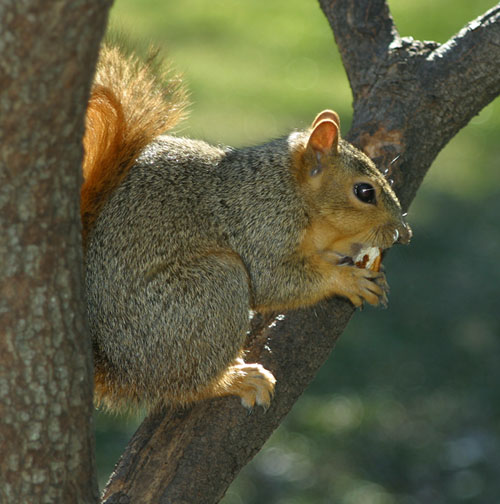Squirrels may be cute, and I enjoy watching squirrels in the woods as much as anyone. I’m less entranced, however, by the squirrel cartel currently occupying my backyard.
A few weeks ago, after returning home from an out of town trip, I noticed something wasn’t quite right with the cedar elm tree in my backyard. An entire branch of the tree appeared to be dead. Inspection close to the trunk revealed that the bark had been peeled off, chewed off actually, girdling the entire branch.
I had noticed more squirrels than usual this summer, and have directed more than one oath at squirrels for bark-chewing in the past. On this same tree for the past several winters I had noticed rather severe disfigurement from squirrel gnawing. This was especially galling to me because the cedar elm under attack was one I had planted myself, and which was finally becoming a useful shade tree. This was the first time squirrel hanky panky had resulted in actual death of part of a tree.
It’s enough to drive one to firearms.
I’ve been curious about squirrel damage to trees for many years, having collected pictures of odd damage that seemed due to squirrels. I have occasionally seen unusual scars and fresh damage most certainly due to squirrels. Some of this damage appears almost artistic, with narrow channels chewed in the bark, almost circling branches and trunks, and damage to the same trees that has taken place for years.

View of squirrel damage to large branches on our cedar elm tree in the winter, when damage is most obvious.
Since my recent damage, a client stopped by our office with a picture of numerous dead branches in his tree and with a sample branch showing the same bark stripping that I observed at my home. I’ve also had several calls this summer about tips of branches mysteriously dropping off trees. In all cases the cuts are smooth and at about a 45 degree angle–more squirrel mischief.
If tree damage wasn’t enough, squirrels can cause significant structural damage to homes. Squirrels have at least three times now attempted (unsuccessfully) to chew and scratch their way into my attic. Once inside, squirrels (or any rodent) can contaminate and damage insulation and chew on wiring, much like they chewed on my tree bark. And as a potential fire hazard, squirrels are far from cute.
So why am I, an entomologist, ranting about squirrels? I am certainly no expert on squirrels, but there is a new resource on squirrel management in the form of a webinar conducted last week by Dr. Steven Vantassel, wildlife specialist with the University of Nebraska. This webinar is available online for viewing at https://learn.extension.org/events/1180. Dr. Vantassel addresses the biology and behavior of several species of tree squirrels, as well as techniques for squirrel-proofing your home (and bird feeders), hazing and trapping nuisance squirrels.
For my part, I’m going to use some of the techniques I’ve learned in the webinar instead of the firearm idea. I think that’s a lot safer for everyone concerned, except maybe the squirrels.
